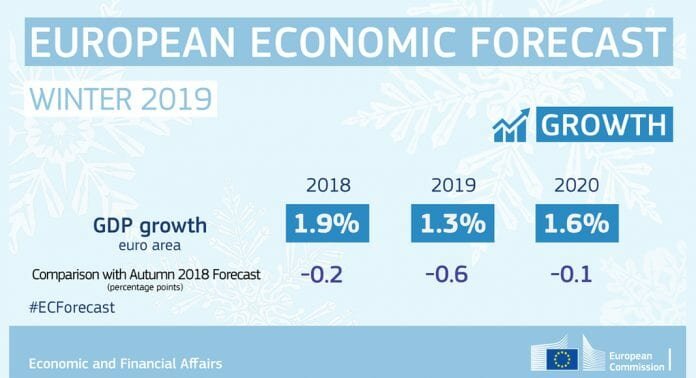
The 2019 Winter Interim Economic Forecast shows growth for the seventh year in a row, with the economy of every Member State expected to grow.
Despite recent years having such high rates of growth, the pace of growth overall is projected to moderate and the outlook is subject to large uncertainty. The Winter 2019 Interim Economic Forecast is based on a set of technical assumptions concerning exchange rates, interest rates and commodity prices.
Economic growth
The Commission has stated that economic momentum at the start of this year was subdued, however the fundamentals remain the same; economic growth is predicted to continue, only at a slower rate.
From the Winter Interim Economic Forecast, the euro area GDP is now forecast to grow by 1.3% in 2019 and 1.6% in 2020 and the EU GDP growth forecast has been revised down to 1.5% in 2019 and 1.7% in 2020.
In comparison, GDP growth in both the euro area and the EU decreased to 1.9% in 2018, down from 2.4% in 2017. This decrease was likely due to the face that economic activity moderated in the second half of last year as global trade slowed growth and output in some Member States were adversely affected by temporary domestic factors.
Inflation

According to the Commission, a sharp drop in energy prices and lower food price consumption are the causal factors to a drop is consumer price inflation in the euro area at the end of 2018. Overall inflation averaged 1.7% in 2018, up from 1.5% in 2017.
For 2019, the euro area inflation is forecast to hit 1.4%, and the EU inflation rate is forecast to average 1.6% this year before picking up again in 2020 to 1.8%.
The response of the Commission on the Winter 2019 Interim Economic Forecast
Valdis Dombrovskis, Vice-President for the Euro and Social Dialogue, also in charge of Financial Stability, Financial Services and Capital Markets Union, said: “All EU countries are expected to continue to grow in 2019, which means more jobs and prosperity. Yet our forecast is revised downwards, in particular for the largest euro area economies. This reflects external factors, such as trade tensions and the slowdown in emerging markets, notably in China. Concerns about the sovereign-bank loop and debt sustainability are resurfacing in some euro area countries. The possibility of a disruptive Brexit creates additional uncertainty. Being aware of these mounting risks is half of the job. The other half is choosing the right mix of policies, such as facilitating investment, redoubling efforts to carry out structural reforms and pursuing prudent fiscal policies.”
Pierre Moscovici, Commissioner for Economic and Financial Affairs, Taxation and Customs, said: “After its 2017 peak, the EU economy’s deceleration is set to continue in 2019, to growth of 1.5%. This slowdown is set to be more pronounced than expected last autumn, especially in the euro area, due to global trade uncertainties and domestic factors in our largest economies. Europe’s economic fundamentals remain solid and we continue to see good news particularly on the jobs front. Growth should rebound gradually in the second half of this year and in 2020.”
Uncertainty
There is still an incredibly high-level of uncertainty surrounding the economic outlook, particularly for the EU, as Brexit still remains a source of uncertainty. Other areas of uncertainty are the trade tensions and the idea that China’s economy may be slowing more sharply than anticipated, meaning global financial markets and many emerging markets are vulnerable to abrupt changes in risk sentiment and growth expectations.


















